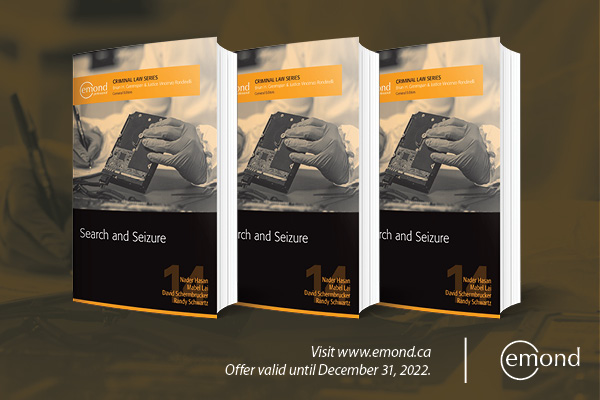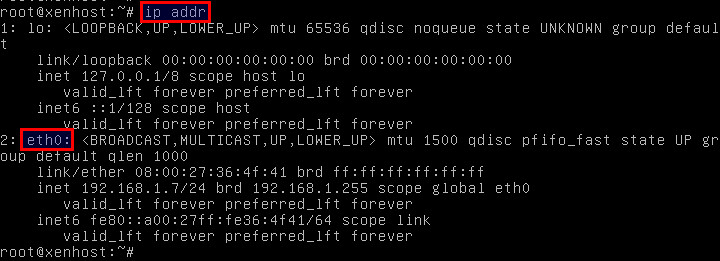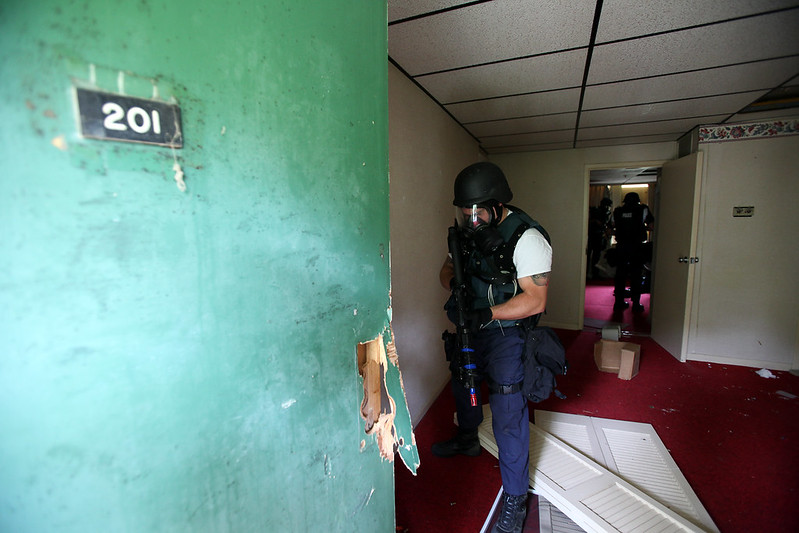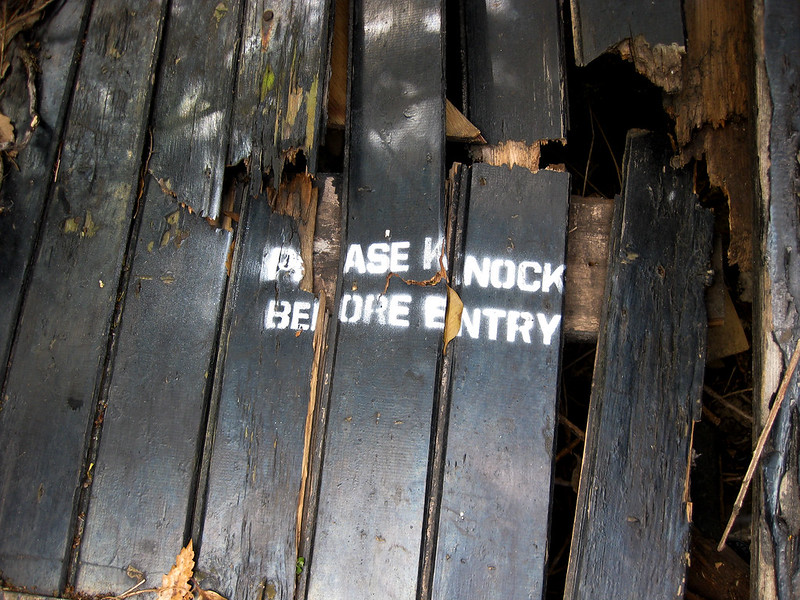This week’s top three summaries: R v Robertson, 2022 ONSC 5795: s.8 #ruse stop, R v JR, 2022 YKCA 9: #corroboration, and R v Favel, 2022 ABKB 727: #normative causation murder.
This week's top case deals with a warrantless search issue. For great general reference on the law of search and seizure, I recommend the Emond title below. It is available for purchase now for our readership with a 10% discount code provided below. To purchase, simply click on image below.
R v Robertson, 2022 ONSC 5795
[November 3, 2022] Charter s.8: Ruse Traffic Safety Stop for Search Purposes [Justice J. R. McCarthy]
AUTHOR’S NOTE: While the case turns on a s.9 violation (ie. the finding of the ruse), the real application for the defence occurs at the stage of undermining the search incident to arrest. This leads to the exclusion of all evidence seized from the vehicle. The interesting portion of this case is the succinct manner in which the judge shows how easily, with a proper analysis, police actions can demonstrate the falsity of their stated objective of a traffic stop. Here the stop was for an allegedly obscured front Ontario licence plate - yet upon stopping neither officer actually went to the front of the vehicle to inspect the plate. In fact, the prior knowledge that the occupant was a known drug dealer immediately put the spot light on the officers actions as they attempted to come up with excuses to stop the vehicle for what was actually a drug search from the beginning.
The Application
The Relevant Facts
[5] On February 7, 2020 the Applicant was detained by Barrie police at a traffic stop while operating a white Mitsubishi Lancer (“the vehicle”).
[6] At approximately 10:21am that morning, while involved in another matter, Hayes observed the vehicle approaching him. The officer noticed a male driver and a front seat passenger whom he recognized as Z.P., a known drug trafficker. Hayes recorded and ran the license plate number of the vehicle and discovered that it was registered to a female. Preoccupied with other matters, neither Hayes nor his partner were able to stop the vehicle to investigate.
[7] At approximately 10:45 am, however, the officers came upon the vehicle a short distance away. This time the unknown male was alone in the vehicle. Hayes testified that he could not see a front license plate; it was either covered with snow or not attached to the vehicle. The officers activated their lights and pulled the vehicle over. The purpose for the vehicle stop was to investigate the license plate and to determine whether the unknown male was a licensed driver. The vehicle stop was authorized under section 216(1) of the Highway Traffic Act, R.S.O. 1990, c. H.8 (“the HTA”).
[8] Hayes approached the driver side of the vehicle while Knight remained behind it. Neither officer ever checked the front license plate to see if it was obscured or missing. The Applicant identified himself upon the officer’s request and stated that he did not have a driver’s license. A CPIC search then revealed that the Applicant was subject to a driving prohibition and a release order with a condition not to operate a motor vehicle.
[9] At 10:52am the Applicant was arrested, removed from the vehicle, searched, and taken to the police cruiser where he was provided rights to counsel at 10:56am.
[10] Knight looked in the vehicle and observed currency in the open driver door. He picked up the currency and then noticed a pencil case which he seized and searched, finding packaged controlled substances. Knight explained that he seized the currency incident to arrest because it is his policy to seize and collect anything of value. He continued the search of the vehicle for reasons of officer safety and under the common law authority. Knight was not certain whether the Applicant would be returning to the vehicle before being taken to the station or if he was going to be released on an undertaking. There remained the risk that the Applicant could access knives or small firearms if he returned to the vehicle. The search was limited to the immediate area of the driver’s seat which included the door, centre console and beneath the seat.
The Applicant's Position
Analysis
Section 9 – Arbitrary Detention
[25] I am persuaded that the two officers were not motivated to affect the vehicle stop by the fact that the front license plate on the subject vehicle was obscured or missing or out of concern that the unknown driver might not be licensed. I say this for the following reasons:
- Hayes apparently had no difficulty in reading the license plate on the vehicle at 10:21am when he first took notice of it. While he did not clarify whether he read the front plate or the back plate, I find that he would more than likely have read the front plate. The vehicle was approaching him from the front. Undoubtedly, he would have recalled that the front plate was missing or obscured had it been necessary for him to divert his attention to the back plate.
- That the front plate became so obscured by snow or ice, or that it suddenly went missing, in the 24 minutes between the officer’s first and second sighting of the vehicle is a proposition too fanciful to be entertained.
- If the weather conditions in Barrie were conducive to the accumulation of snow or ice on the Applicant’s front plate sufficient to obscure it from view, his could not realistically have been the only vehicle in the vicinity to be in that condition. I find it highly unlikely that the two officers would have felt it necessary to pull the vehicle over in such conditions especially when Hayes had been able to detect and record the plate number just minutes before.
- The fact that neither of the two officers took the time to walk the handful of steps to the front of the vehicle in the moments following the vehicle stop to investigate whether the plate was obscured or missing leads me to conclude that the entire license plate issue was simply a ruse. I find that the observation made of Z.P. in the vehicle moments before the traffic stop was the sole factor which created the police officer’s interest in the vehicle, and which motivated them to rely on the broad powers afforded by the HTA to pull the vehicle over to investigate a possible drug deal.
- I am left to question how, in a city the size of Barrie, two traffic officers could randomly come upon the very same vehicle in which they had spotted a known drug dealer 24 minutes before. The chances that they would are slim to the point of impossibly remote. I infer that spotting Z.P. in that vehicle prompted the officers to either follow or search for that vehicle in the context of a drug investigation
- I do not accept Hayes’ evidence that the fact that the plates were registered to a female raised a legitimate concern that the driver may not be licensed. This alone should not have raised police suspicion or served as the basis for a vehicle stop....
Sections 10(a) and (b)
Section 8 – Illegal search
S. 24(2) and the Grant analysis
[39] There is no doubt that police can easily employ the broad powers under the HTA to effect vehicle stops. That certainly serves a commendable objective: to ensure the safety of the public on roads and highways. But where those powers are employed to arbitrarily detain individuals who are not committing HTA offences, Charter rights are not just infringed, but eviscerated and in an almost callous fashion. This type of police conduct must be strongly discouraged.
[50] The impugned evidence shall be excluded at trial. The Crown is precluded from introducing or referring to any evidence found in the Applicant’s vehicle at or after 10:45am on February 7, 2020.
R v J.R. , 2022 YKCA 9
[October 27, 2022] Corroboration of a Vetrovec Witness [Reasons by Fitch J.A. with Abrioux and Horsman JJ.A. concurring]
AUTHOR’S NOTE: The definition of corroboration can shift with the purpose for which it is used. For example, in a Mr. Big admissibility context, corroborative evidence has a shifting technical meaning that is the subject of some inconsistency by the courts. However, in this case the corroboration was about what in effect became a Vetrovec witness (someone whose evidence cannot be relied upon without corroborative evidence). Here the YKCA found that the judge committed an error when she found that evidence of another witness corroborated a Vetrovec complainant when if failed to distinguish between the accused's account and the complainant's account. In other words, if both accounts are possible on the evidence of the "corroborative" witness, then their evidence is not corroborative in any sense of the word. The conviction was set aside and an acquittal entered on the count requiring corroboration.
FITCH J.A.:
I. Introduction
II. Background
[16] The complainant’s allegations of abuse against his grandfather emerged after his conviction for sexual assault, in the midst of his parents’ divorce and ensuing custody battle.
[17] Against this background, the trial judge accepted that there was a “clear risk” in relying on the complainant’s testimony in the absence of confirmatory evidence. I understand this self-direction to be an acknowledgment by the trial judge that it would be unsafe to convict the appellant on the unconfirmed evidence of the complainant. She applied this self-direction in her reasons for judgment and acquitted where there was no evidence confirming the complainant’s account.
Count 1: Common Assault
[21] The appellant testified that he went into the complainant’s bedroom after being informed that the complainant had punched his grandmother—the appellant’s wife. He said he wanted to find out what had happened. When he admonished the complainant saying, “You must never hit your grandmother”, the complainant started swinging and kicking at him. He testified that he wrapped his arms around the complainant to restrain him and pinned him to the bed....
[341] [The complainant’s] evidence that his grandfather pushed him and pinned him on the bed is corroborated by [his sister’s] evidence that she recalled an incident, when she was between the ages of seven and 10 years old, when [the complainant] had gotten into trouble, and sent to his room. As she wanted to know what was happening, she walked by [the complainant’s] bedroom and saw, in passing, that her grandfather had [him] pinned to his bed. According to [the sister’s] evidence her grandfather was leaning his weight on [the complainant], and holding him down. She stated that her grandfather was using more of his side to hold [the complainant] down. She added that she could hear [the complainant] struggling and screaming while this incident was happening.
Count 3: Assault with a Weapon
[45] I appreciate that reasons must be read as a whole. I acknowledge, in this regard, that the judge reproduced the relevant portions of W.(D.) in her reasons for judgment. The second prong of the W.(D.) inquiry begs consideration of whether evidence favourable to the accused, even if not accepted, gives rise to a reasonable doubt. But even if it could be said that the judge understood her task at the second stage of the inquiry to encompass evidence favourable to the defence given by the complainant, the reasons for judgment do not reflect an appreciation that, in the context of Count 3, she could not limit herself to acting only on those portions of the complainant’s evidence that were independently confirmed.
R v Favel, 2022 ABKB 727
[October 31, 2022] [Justice W.N. Renke]
AUTHOR’S NOTE: First Degree Murder causation requires evidence of normative causation. This means the actions of the accused have to "substantially" contribute to the death in order for the person to be held responsible for first degree murder. Here, the question was whether people who contributed by binding the victim sufficiently contributed to the strangulation death that occurred afterwards through the actions of one of them. In the circumstances of this case, the act of binding was not sufficient to even merit a jury hearing about the argument - the judge granted a directed verdict application by the defence.
I. Test
[16] In determining whether to grant a no-evidence motion, the trial judge must ask “whether or not there is any evidence upon which a reasonable jury properly instructed could return a verdict of guilty” (R. v. Arcuri, 2001 SCC 54, [2001] 2 S.C.R. 828, at para. 21, quoting United States of America v. Shephard, [1977] 2 S.C.R. 1067, at p. 1080; see also R. v. Monteleone, [1987] 2 S.C.R. 154, at pp. 160-61). The Crown must adduce some evidence of culpability for every essential definitional element of the crime (R. v. Charemski, [1998] 1 S.C.R. 679, at paras. 2-3). If there is any such admissible evidence, a directed verdict is not available (Monteleone, at pp. 160-61; R. v. Barros, 2011 SCC 51, [2011] 3 S.C.R. 368, at para. 48).
Justice Martin cited cases referred to by counsel in argument, including Charemski, Arcuri, and Shepard.
[5] The test is not whether the Crown simply has some evidence that supports the Crown’s theory of the case. Rather, as Justice McLachlin emphasized in Charemksi at para 20, the test is “whether the evidence is capable of supporting a verdict of guilt beyond a reasonable doubt. If it is not, the judge must direct an acquittal, since it would be impossible for a reasonable jury to convict legally on the evidence” (emphasis added, see also para 35).
- the test is the same whether the evidence is direct or circumstantial (para 22)
- the test is the same whether or not the Crown’s case contains exculpatory evidence (para 29 - “Thus, where the Crown has adduced direct evidence on all the elements of the offence, the preliminary inquiry judge must commit the accused to trial even if the defence proffers exculpatory evidence:” R v Sazant, 2004 SCC 77 at para 16)
- the trier of fact determines whether and how far the evidence is to be believed but the judge as trier of law does not assess credibility (paras 22, 23, 30 (Sazant at para 18))
- to the extent that the Crown relies on circumstantial evidence to prove an element of an offence, the judge must engage in a limited weighing of the evidence. The judge must determine whether the evidence is reasonably capable of supporting the inferences urged by the Crown (at para 23). Further, that limited weighing must be of the “whole of the evidence (i.e. including any defence evidence)” (para 29).
In Sazant, Chief Justice McLachlin confirmed at para 18 that if “more than one inference can be drawn from the evidence, only the inferences that favour the Crown are to be considered.”
C. Secondary Liability for First Degree Murder
4. Substantial Cause
E. Sufficient Causal Contribution?
[150] One issue is whether I should consider this issue at all. Is this an issue that’s best left to the trier of fact? My hesitation, so far as I can discern, is founded on two reflections. First, the issue of whether there is a sufficient causal contribution is a normative decision as opposed to a factual decision. Second, the Supreme Court has confirmed in cases like Nette and Harbottle that in effect s. 231(5) is in the nature of a sentencing provision. In light of these reflections, perhaps the issue of sufficient causal contribution should not be considered by the trier of law in a directed verdict application.
[151] I have come to the conclusion that my misgivings are misplaced. The accuseds are entitled to a determination of whether a reasonably jury properly instructed could convict respecting the charges they face, first-degree murder. This is the charged offence. Therefore, a directed verdict application is available, in full. I am not entitled to walk away or try to avoid that decision.
[154] Another question then arises. Given that the determination of sufficient causal contribution is normative, given that the issue is whether a reasonable jury properly instructed could find a sufficient causal contribution, does it follow that just because the Crown has established that the accuseds are each parties to murder, that each has played a causal role in the death of Mr. Desjarlais that, by that very fact, means that there is evidence on which a reasonable jury properly instructed could convict for first-degree murder?
[155] In my view, an affirmative response would be incorrect. More is required than simply a contribution to the death, to the murder, to attract the application of s. 231(5). I’ll repeat a passage mentioned earlier. Justice Arbour commented in Nette at para 62 that “The degree of participation in the killing by a party whose liability for murder is based on aiding or abetting under s. 21(1)(b) or (c) of the Criminal Code ... may, under the Harbottle formulation, be insufficient to permit a finding that the murder amounts to first degree under s. 231(5) ....”
[159] The physical contributions of the accuseds to Mr. Desjarlais’ death were, on their accounts, roughly similar. Each accused admitted binding Mr. Desjarlais’ feet or ankles. The result in each case was a contribution to the effectiveness of the choke and a reduction in Mr. Desjarlais’ ability to escape. Mr. Favel had the added contribution of abetting, of verbal encouragement.
[161] Ms. Omeasoo left while Joe was still alive.
F. Conclusion
[171] The directed verdict applications then are successful to the extent that the most serious offence reasonably available on the evidence against each accused is second degree murder.







